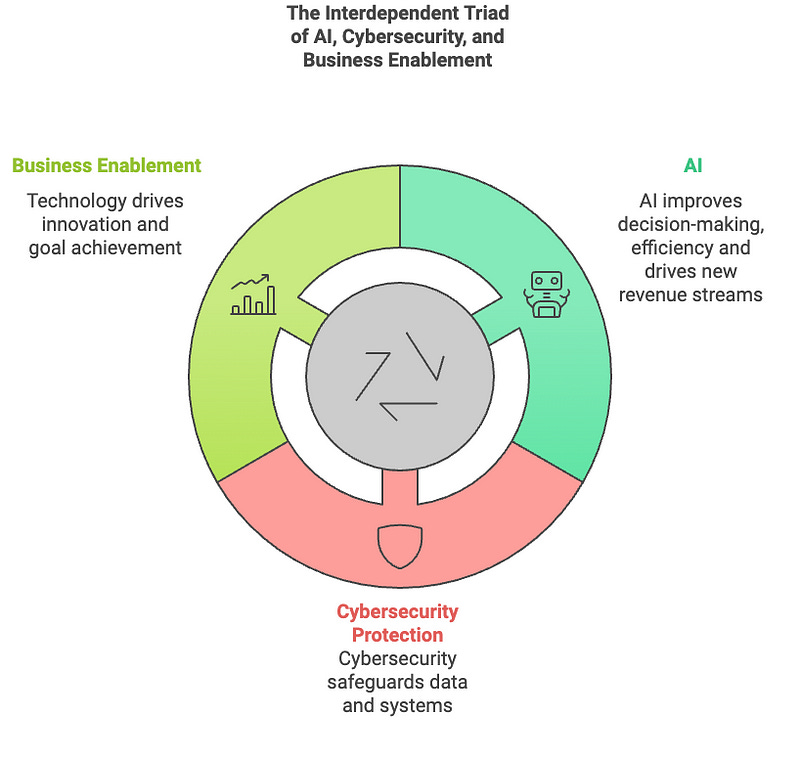The Interdependent Triad of AI, Cybersecurity, and Business Enablement
Imagine a modern enterprise striving to seize competitive advantage in an era of relentless digital transformation. It’s a world where…
Imagine a modern enterprise striving to seize competitive advantage in an era of relentless digital transformation. It’s a world where businesses grapple with a new kind of “triple constraint,” not just the familiar project management triangle of Time, Cost, and Quality. Instead, consider a strategic triad composed of Artificial Intelligence (AI), Cybersecurity, and Business Enablement. Like the classic constraints, these three dimensions are inextricably intertwined, pushing and pulling on one another. Optimize one, and you exert pressure on the others. Fail to balance them, and the entire enterprise risks collapsing under the weight of missed opportunities or catastrophic breaches.
This blog plunges deep into that intersection, illustrating how AI, Cybersecurity, and Business Enablement form a holistic system of interdependencies that must be harmonized. Much like how cutting corners on Quality to meet Time and Cost constraints triggers long-term trade-offs, neglecting any vertex of our new triad may deliver short-term gains but risks long-term instability and vulnerability. Ultimately, organizations that find equilibrium in this triple helix will flourish, while those that ignore its delicate interplay may find themselves either outpaced by technological Darwinism or undone by their own digital frailties.
The Triad’s Three Nodes
Node 1: Artificial Intelligence (AI)
AI is the powerhouse of digital advancement, a disruptive force that drives unprecedented efficiencies, enables deeper data-driven insights, and personalizes customer experiences with near-magical precision. It’s the computational engine that can turn mountains of raw data into actionable intelligence at scale. But just as doubling production capacity in manufacturing doesn’t guarantee product quality, deploying AI without safeguards can lead to massive data privacy violations, algorithmic biases, and unpredictable operational risks. The potency of AI demands a commensurate commitment to security, trust, and strategic governance.
Node 2: Cybersecurity
Cybersecurity serves as the immune system of the digital enterprise. In a universe where AI’s power is dazzling, it’s easy to forget that shining beacons attract predators. Cyber threats-ranging from low-level nuisance malware to nation-state backed Advanced Persistent Threats-compete with organizations for their data, integrity, and reputation. Just as reducing project costs can compromise product quality, neglecting cybersecurity to accelerate AI deployments or business initiatives can be catastrophic. Cybersecurity’s job is twofold: to shield AI engines from infiltration and sabotage, and to ensure that the data fueling AI insights remains authentic, confidential, and untampered. Its vigilance lays the groundwork for sustainable progress, preventing the organization from building tomorrow’s innovations on foundations of quicksand.
Node 3: Business Enablement
Business Enablement-think of it as the strategic realization of potential-carries the mantle of turning technological prowess into tangible outcomes: market growth, customer satisfaction, operational resilience, and shareholder value. It’s not enough to implement AI-driven solutions if they don’t align with business objectives, streamline workflows, and enrich the end-user experience. Yet, the temptation to rush enablement without securing its digital underbelly is strong. Moving faster than your cybersecurity guardrails allow might unlock short-term market gains but invite existential crises when the next breach hits. Conversely, over-investing in security measures without unlocking AI-driven innovations can leave you technologically lagging and miss the exponential upsides of digital transformation. Business Enablement translates the interplay of AI and Cybersecurity into strategic advantage-if balanced wisely.
Interlinkages and Trade-Offs
Balancing AI, Cybersecurity, and Business Enablement demands strategic nuance. It’s a relentless calibration act, akin to maintaining equilibrium in the classic Time-Cost-Quality triangle. Choose to double down on AI capabilities-scaling machine learning models, integrating natural language processing into customer service, or harnessing generative AI for product design-and you must also intensify cybersecurity measures. Every advanced AI system is a potential entry point for malicious actors. Without robust security, your AI-driven differentiator becomes a vulnerability. And without careful business alignment, your AI investments devolve into costly science projects that fail to yield measurable ROI.
Conversely, if you invest heavily in Cybersecurity to the point of imposing draconian constraints-sprawling intrusion detection layers, rigorous encryption protocols, exhaustive compliance checks-you might slow the velocity of business enablement. Complexity can stifle innovation. Some organizations become so locked down that AI initiatives can barely get off the ground, caught in a maze of approvals and risk-averse governance. The delicate dance requires forward-looking decision-makers who understand that robust security frameworks should be enablers of innovation, not barriers.
And if Business Enablement aims for hyper-acceleration-rushing to market with new AI-powered features-without corresponding cybersecurity diligence, the fruits of innovation may turn to ashes in the wake of a public breach. Just as sacrificing Quality for speed erodes long-term brand trust, neglecting Cybersecurity in the pursuit of rapid AI-driven growth leads to strategic vulnerability. The path of least resistance often leads straight into an adversary’s hands.
The Virtuous Cycle
When properly calibrated, the interplay of AI, Cybersecurity, and Business Enablement forms a virtuous cycle. AI’s predictive analytics and anomaly detection capabilities can supercharge Cybersecurity, enabling dynamic threat intelligence, automated incident response, and proactive vulnerability management. In turn, a fortified cybersecurity landscape grants businesses freedom to innovate, confident that transformative AI applications won’t become Achilles’ heels. This trust and resilience accelerate Business Enablement, empowering leaders to make bolder bets, expand into new markets, and automate critical functions without fear.
As business initiatives flourish, they yield new datasets and feedback loops that further enrich AI models. The result is an ecosystem feeding on its own momentum: AI enhances security, security fuels confident enablement, and enablement creates more valuable data for AI to exploit. This cyclical synergy is the holy grail of strategic equilibrium, a state where technological innovation, digital trustworthiness, and market agility co-evolve.
Achieving Equilibrium in the New Triple Constraint
Treat AI, Cybersecurity, and Business Enablement like the new “Time, Cost, Quality” triangle. The old project management triad taught us that no dimension is independent, and improving one aspect often demands trade-offs in the others. The same holds true for our modern digital environment. AI sparks transformative potential; Cybersecurity ensures trust and stability; Business Enablement turns raw capability into tangible value. Favoring one vertex at the expense of the others may yield short-term wins, but undermines the long-term health and competitiveness of the enterprise.
Forward-thinking organizations must adopt a holistic mindset. They must be contrarian enough to challenge linear thinking-AI is not just a tech toy, Cybersecurity is not merely a defensive cost center, and Business Enablement is not only a cheerleader for growth. Instead, each dimension feeds and restrains the others. By understanding this interplay, aligning leadership priorities, and carefully allocating resources, businesses can leverage technology’s power safely, ensuring that the digital revolution they embrace today becomes their platform for sustained success tomorrow.
Originally published at https://www.linkedin.com.




